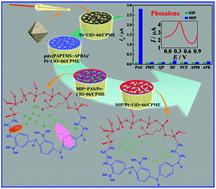Our official English website, www.x-mol.net, welcomes your
feedback! (Note: you will need to create a separate account there.)
A disposable molecularly imprinted electrochemical sensor for the ultra-trace detection of the organophosphorus insecticide phosalone employing monodisperse Pt-doped UiO-66 for signal amplification.
Analyst ( IF 3.6 ) Pub Date : 2020-03-25 , DOI: 10.1039/d0an00278j Liping Xu 1 , Jiebin Li , Jiajia Zhang , Junyong Sun , Tian Gan , Yanming Liu
Analyst ( IF 3.6 ) Pub Date : 2020-03-25 , DOI: 10.1039/d0an00278j Liping Xu 1 , Jiebin Li , Jiajia Zhang , Junyong Sun , Tian Gan , Yanming Liu
Affiliation

|
In this work, a disposable molecularly imprinted electrochemical sensor was developed towards the highly sensitive and selective detection of the organophosphorus insecticide phosalone (PAS), employing a home-made carbon paste microelectrode (CPME) modified with a Zr-based metal-organic framework catalyst (Pt-UiO-66) and a mesoporous structured conductive molecularly imprinted polymer (MIP). Pt-UiO-66 octahedra with isolated dispersed Pt nanoparticle active sites were firstly incorporated into the CPME to provide a remarkably amplified signal for voltammetric determination. The mesoporous MIP was then synthesized onto the Pt-UiO-66/CPME via electropolymerization and a subsequent sol-gel process, which could bind the PAS template molecules through hydrogen bond, coordinate bonding, hydrophobic interaction, and π-π stacking interaction. Morphological, structural, and electrochemical characterization studies revealed that this nano-sized MIP provided excellent features for PAS detection, including high porosity, large surface area, enhanced electron-transport ability, greatly improved diffusion capacity, and strong recognition specificity. Therefore, the resulting sensor exhibited an outstanding linearly proportional concentration domain of 0.50 nM-20 μM, low detection limit of 0.078 nM, marked selectivity over certain interferences with similar configurations, considerable repeatability, reproducibility, and stability for the analysis of PAS. Moreover, the sensor was successfully applied for the determination of PAS in agricultural products and environmental samples with results in good compatibility with a chromatographic method, indicative of the high reliability and practicability. Such an electrochemical sensor might open a novel window for the investigation of selective sensing of small organic species from their analogues coupled with the molecular imprinting technique.
中文翻译:

一次性分子印迹电化学传感器,用于超痕量检测有机磷杀虫剂phosalone,采用单分散Pt掺杂的UiO-66进行信号放大。
在这项工作中,开发了一种一次性分子印迹电化学传感器,以对有机磷杀虫剂膦(PAS)进行高灵敏度和选择性检测,方法是使用经过Zr基金属有机骨架催化剂修饰的自制碳糊微电极(CPME)。 (Pt-UiO-66)和中孔结构化导电分子印迹聚合物(MIP)。首先将具有分离的分散的Pt纳米颗粒活性位点的Pt-UiO-66八面体引入CPME中,以提供用于伏安测定的显着放大信号。然后通过电聚合和随后的溶胶-凝胶工艺将介孔MIP合成到Pt-UiO-66 / CPME上,该过程可以通过氢键,配位键,疏水相互作用和π-π堆积相互作用键合PAS模板分子。形态,结构和电化学表征研究表明,这种纳米级MIP为PAS检测提供了出色的功能,包括高孔隙率,大表面积,增强的电子传输能力,大大提高的扩散能力和强大的识别特异性。因此,所得传感器表现出出色的线性比例浓度域(0.50 nM-20μM),低检测限(0.078 nM),对具有相似配置的某些干扰具有明显的选择性,可观的可重复性,重现性以及用于PAS分析的稳定性。此外,该传感器已成功应用于农产品和环境样品中PAS的测定,与色谱法具有良好的兼容性,表示高可靠性和实用性。这种电化学传感器可能会为研究小型有机物从其类似物与分子印迹技术的选择性感应研究中打开一个新的窗口。
更新日期:2020-03-02
中文翻译:

一次性分子印迹电化学传感器,用于超痕量检测有机磷杀虫剂phosalone,采用单分散Pt掺杂的UiO-66进行信号放大。
在这项工作中,开发了一种一次性分子印迹电化学传感器,以对有机磷杀虫剂膦(PAS)进行高灵敏度和选择性检测,方法是使用经过Zr基金属有机骨架催化剂修饰的自制碳糊微电极(CPME)。 (Pt-UiO-66)和中孔结构化导电分子印迹聚合物(MIP)。首先将具有分离的分散的Pt纳米颗粒活性位点的Pt-UiO-66八面体引入CPME中,以提供用于伏安测定的显着放大信号。然后通过电聚合和随后的溶胶-凝胶工艺将介孔MIP合成到Pt-UiO-66 / CPME上,该过程可以通过氢键,配位键,疏水相互作用和π-π堆积相互作用键合PAS模板分子。形态,结构和电化学表征研究表明,这种纳米级MIP为PAS检测提供了出色的功能,包括高孔隙率,大表面积,增强的电子传输能力,大大提高的扩散能力和强大的识别特异性。因此,所得传感器表现出出色的线性比例浓度域(0.50 nM-20μM),低检测限(0.078 nM),对具有相似配置的某些干扰具有明显的选择性,可观的可重复性,重现性以及用于PAS分析的稳定性。此外,该传感器已成功应用于农产品和环境样品中PAS的测定,与色谱法具有良好的兼容性,表示高可靠性和实用性。这种电化学传感器可能会为研究小型有机物从其类似物与分子印迹技术的选择性感应研究中打开一个新的窗口。











































 京公网安备 11010802027423号
京公网安备 11010802027423号